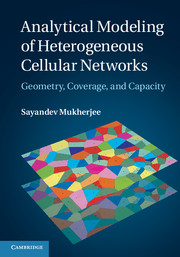Book contents
- Frontmatter
- Contents
- Preface
- Acknowledgemants
- List of notation
- List of acronyms and abbreviations
- 1 Introduction
- 2 Structure of the SINR calculation problem
- 3 Poisson point processes
- 4 SINR analysis for a single tier with fixed power
- 5 SINR analysis for multiple tiers with fixed powers
- 6 SINR analysis with power control
- 7 Spectral and energy efficiency analysis
- 8 Closing thoughts: future heterogeneous networks
- Appendix A Some common probability distributions
- Appendix B HCNs in LTE
- References
- Author index
- Subject index
2 - Structure of the SINR calculation problem
Published online by Cambridge University Press: 18 December 2013
- Frontmatter
- Contents
- Preface
- Acknowledgemants
- List of notation
- List of acronyms and abbreviations
- 1 Introduction
- 2 Structure of the SINR calculation problem
- 3 Poisson point processes
- 4 SINR analysis for a single tier with fixed power
- 5 SINR analysis for multiple tiers with fixed powers
- 6 SINR analysis with power control
- 7 Spectral and energy efficiency analysis
- 8 Closing thoughts: future heterogeneous networks
- Appendix A Some common probability distributions
- Appendix B HCNs in LTE
- References
- Author index
- Subject index
Summary
We begin with the simple SINR calculation problem of Chapter 1 and generalize it to a deployment with more than one tier of BSs. We then examine the features of the problem that permit us to evaluate the CCDF of the SIR in terms of Laplace transforms of fading coefficients on the links to the user location from the BSs in the tiers. Then we abstract the problem formulation slightly in order to define a general probability calculation of a vector of random variables, which we call the canonical problem. We derive general results and conditions under which the canonical probability may be expressed in terms of Laplace transforms of certain random variables. This is one half of the mathematical core of the book. The other half is the study of stochastic models that yield tractable analytic expressions for the Laplace transforms in the canonical probability calculation, and we discuss that topic in Chapter 3.
Statement of the SINR calculation problem
Let us return to the problem of computing the distribution of the SINR at an arbitrarily located user somewhere in a network with one or more tiers of BSs. We begin by defining the candidate serving BSs, the criteria for their selection, the criterion for choosing the BS that will serve the user, and some notation to represent received power from the candidate serving BSs and from all interferers.
Candidate serving BSs and the serving BS
Consider a snapshot of the wireless network at a particular moment in time.
- Type
- Chapter
- Information
- Analytical Modeling of Heterogeneous Cellular NetworksGeometry, Coverage, and Capacity, pp. 8 - 22Publisher: Cambridge University PressPrint publication year: 2014



